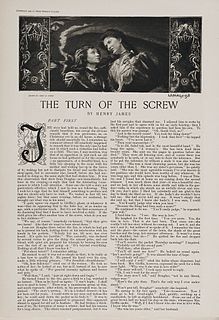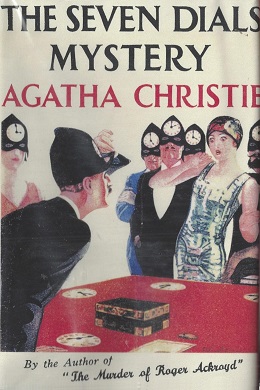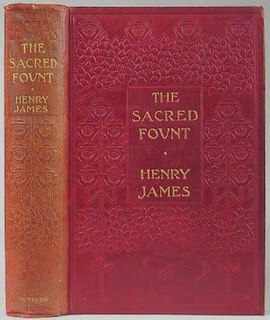Related Research Articles

Henry Wadsworth Longfellow was an American poet and educator whose works include "Paul Revere's Ride", The Song of Hiawatha, and Evangeline. He was also the first American to translate Dante Alighieri's Divine Comedy and was one of the Fireside Poets from New England.

Henry James was an American author, who became a British subject in the last year of his life, regarded as a key transitional figure between literary realism and literary modernism and is considered by many to be among the greatest novelists in the English language. He was the son of Henry James Sr. and the brother of renowned philosopher and psychologist William James and diarist Alice James.

The Turn of the Screw is an 1898 horror novella by Henry James that first appeared in serial format in Collier's Weekly magazine. In October 1898 it appeared in The Two Magics, a book published by Macmillan in New York City and Heinemann in London. Classified as both gothic fiction and a ghost story, the novella focuses on a governess who, caring for two children at a remote estate, becomes convinced that the grounds are haunted.

James Russell Lowell was an American Romantic poet, critic, editor, and diplomat. He is associated with the Fireside Poets, a group of New England writers who were among the first American poets that rivaled the popularity of British poets. These writers usually used conventional forms and meters in their poetry, making them suitable for families entertaining at their fireside.

The Seven Dials Mystery is a work of detective fiction by Agatha Christie, first published in the UK by William Collins & Sons on 24 January 1929 and in the US by Dodd, Mead and Company later in the same year. The UK edition retailed at seven shillings and sixpence (7/6) and the US edition at $2.00.

The Secret of Chimneys is a work of detective fiction by British writer Agatha Christie, first published in the UK by The Bodley Head in June 1925 and in the US by Dodd, Mead and Company later in the same year. It introduces the characters of Superintendent Battle and Lady Eileen "Bundle" Brent. The UK edition retailed at seven shillings and sixpence (7/6) and the US edition at $2.00.

The Portrait of a Lady is a novel by Henry James, first published as a serial in The Atlantic Monthly and Macmillan's Magazine in 1880–81 and then as a book in 1881. It is one of James's most popular long novels and is regarded by critics as one of his finest.

Daisy Miller is a novel by Henry James that first appeared in Cornhill Magazine in June–July 1878, and in book form the following year. It portrays the courtship of the beautiful American girl Daisy Miller by Winterbourne, a sophisticated compatriot of hers. His pursuit of her is hampered by her own flirtatiousness, which is frowned upon by the other expatriates when they meet in Switzerland and Italy.

The Awkward Age is a novel by Henry James, first published as a serial in Harper's Weekly in 1898–1899 and then as a book later in 1899. Originally conceived as a brief, light story about the complications created in her family's social set by a young girl coming of age, the novel expanded into a general treatment of decadence and corruption in English fin de siècle life. James presents the novel almost entirely in dialogue, an experiment that adds to the immediacy of the scenes but also creates serious ambiguities about characters and their motives.

The Aspern Papers is a novella by American writer Henry James, originally published in The Atlantic Monthly in 1888, with its first book publication later in the same year. One of James's best-known and most acclaimed longer tales, The Aspern Papers is based on the letters Percy Bysshe Shelley wrote to Mary Shelley's stepsister, Claire Clairmont, who saved them until she died. Set in Venice, The Aspern Papers demonstrates James's ability to generate suspense while never neglecting the development of his characters.

Washington Square is a short novel by Henry James. Originally published in 1880 as a serial in Cornhill Magazine and Harper's New Monthly Magazine, it is a structurally simple tragicomedy that recounts the conflict between a dull but sweet daughter and her brilliant, unemotional father. The plot of the novel is based upon a true story told to James by his close friend, British actress Fanny Kemble. The book is often compared with Jane Austen's work for the clarity and grace of its prose and its intense focus on family relationships. James was not a great fan of Washington Square. He tried to read it over for inclusion in the New York Edition of his fiction (1907–1909) but found that he could not, so the novel was not included. Readers, though, have sufficiently enjoyed the book to make it one of the more popular of James's works. Indeed, and has since been used in schools all over the world.

The Princess Casamassima is a novel by Henry James, first published as a serial in The Atlantic Monthly in 1885 and 1886 and then as a book in 1886. It is the story of an intelligent but confused young London bookbinder, Hyacinth Robinson, who becomes involved in radical politics and a terrorist assassination plot. The book is unusual in the Jamesian canon for dealing with such a violent political subject. But it is often paired with another novel published by James in the same year, The Bostonians, which is also concerned with political issues, though in a much less tragic manner.

The Bostonians is a novel by Henry James, first published as a serial in The Century Magazine in 1885–1886 and then as a book in 1886. This bittersweet tragicomedy centres on an odd triangle of characters: Basil Ransom, a political conservative from Mississippi; Olive Chancellor, Ransom's cousin and a Boston feminist; and Verena Tarrant, a pretty, young protégée of Olive's in the feminist movement. The storyline concerns the struggle between Ransom and Olive for Verena's allegiance and affection, though the novel also includes a wide panorama of political activists, newspaper people, and quirky eccentrics.

The Sacred Fount is a novel by Henry James, first published in 1901. This strange, often baffling book concerns an unnamed narrator who attempts to discover the truth about the love lives of his fellow guests at a weekend party in the English countryside. He spurns the "detective and keyhole" methods as ignoble, and instead tries to decipher these relationships purely from the behavior and appearance of each guest. He expends huge resources of energy and ingenuity on his theories, much to the bemusement of some people at the party.
The Reverberator is a short novel by Henry James, first published as a serial in Macmillan's Magazine in 1888 and then as a book later the same year. Described by the leading web authority on Henry James as "a delightful Parisian bonbon," the comedy traces the complications that result when nasty but true stories about a Paris family get into the American scandal sheet of the novel's title.
Edward (Charles) Wagenknecht was an American literary critic and teacher who specialized in 19th century American literature. He wrote and edited many books on literature and movies, and taught for many years at various universities, including the University of Chicago and Boston University. He also contributed many book reviews and other writings to such newspapers as the Boston Herald, The New York Times, and the Chicago Tribune and to such magazines as The Yale Review and The Atlantic Monthly.
A London Life is a novella by Henry James, first published in Scribner's Magazine in 1888. The plot revolves around a crumbling marriage and its impact on many other people, especially Laura Wing, the sister of the soon-to-be-divorced wife. Laura is a classic Jamesian "central consciousness," whose reflections and emotions color the presentation of the storyline and the other characters. The tale is notable for its straightforward, even hard-edged approach to sexuality and divorce. This might reflect the influence of French naturalism on James during the 1880s.

Letting Go (1962) is the first full-length novel written by Philip Roth and is set in the 1950s.

Hyperion: A Romance is one of Henry Wadsworth Longfellow's earliest works, published in 1839. It is a prose romance which was published alongside his first volume of poems, Voices of the Night.
Letters from Three Lovers is a 1973 made-for-television drama film directed by John Erman. An ABC Movie of the Week and a sequel to The Letters (1973), the film is co-produced by Aaron Spelling, written by Ann Marcus and stars Martin Sheen, Belinda Montgomery, Robert Sterling, June Allyson, Ken Berry and Juliet Mills, among others.
References
- The Tales of Henry James by Edward Wagenknecht (New York: Frederick Ungar Publishing Co. 1984) ISBN 0-8044-2957-X
- A Henry James Encyclopedia by Robert L. Gale (New York: Greenwood Press 1989) ISBN 0-313-25846-5
- A Companion to Henry James Studies edited by Daniel Fogel (Westport, CT: Greenwood Press 1993) ISBN 0-313-25792-2
- David Engels: "...reminding me strongly of some diminutive Hellenised Roman of the third century." Spätantike, Kulturpessimismus, Deutschenbild in Henry James' "A Bundle of Letters", in: Sprachkunst. Beiträge zur Literaturwissenschaft, vol. 41, 2010, 85-102.